
Taurus handguns have come a long way in terms of quality while retaining their affordable prices, one of the most recent examples of that is the Taurus GX4.
Taurus of Brazil began operations in 1939 as a tool and die forging plant. In 1941, they began producing firearms, and later, in 1968, commenced exportation of guns to the USA. The first Taurus handgun that I ever saw and handled was nearly 50 years ago. It was a nickel-plated revolver in .38 Special and had a close resemblance to a Smith & Wesson Model 10. I noted that the cylinder flutes were serrated, something I found odd. The checkered wood grips appeared somewhat amateurish, and the curved trigger just seemed to dangle from the frame inside the trigger guard. An “ugly duckling” to be sure.
Besides revolvers, Taurus purchased the machinery from Beretta to manufacture semi-automatic pistols, after Beretta had completed a contract with the Brazilian military. Unfortunately, the Taurus reputation suffered in these early attempts at gun-making, and their firearms have been the butt of jokes and more than a little contempt that’s lasted until this very day.
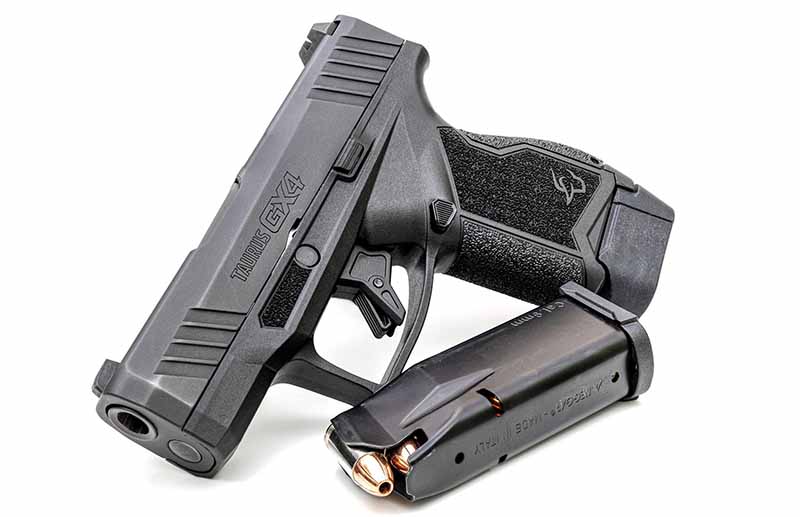
Things Have Changed
Like most American gun enthusiasts, I wasn’t a big fan of Taurus. I’d tested a few over the years, and by and large the revolvers ran just fine, but the autoloaders were another story. I had troubles with function and reliability, and on the Commander-size 1911 I was shooting, the extractor just fell out of the gun.
But several years ago, things began to change. I evaluated a Taurus Model 692 revolver and then took it to Gunsite for the 250 Revolver Course. No issues whatsoever. Next, I tested one of the G3c sub-compact 9mm pistols. I was impressed enough with this Taurus product that it has become my semi-auto EDC. Then, when I thought Taurus had already “raised the bar” to new heights, along comes the GX4.
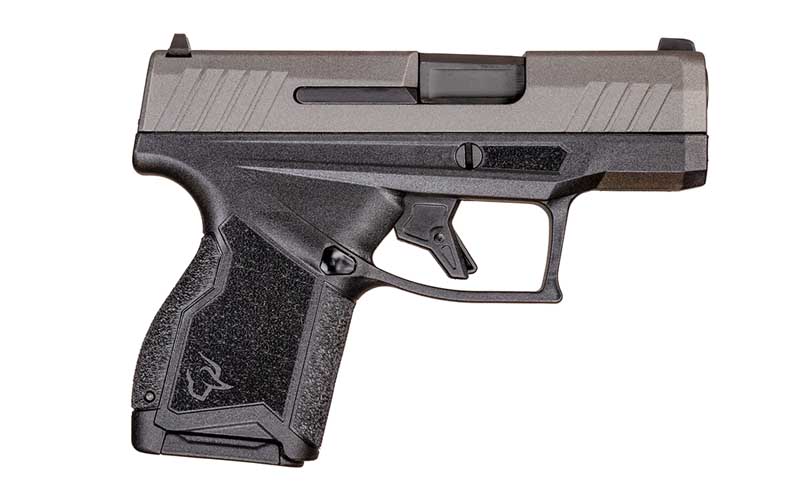
The New Taurus
Taurus has redefined the micro-sized pistol with the introduction of the GX4. In essence, the buyer gets many of the features found in a service-size 9mm pistol that has been downsized to what was once the province of a single-stack .380 ACP. Having a 3.06-inch barrel, the overall length has been kept to 6.05 inches, with a height of 4.4 inches and a width of 1.08 inches, giving it an empty weight of just 18.5 ounces. Now, add an 11-round magazine and with one in the chamber, you have a dozen shots of 9mm performance on tap in a pistol about the size of your palm.
From top to bottom, you have fixed steel sights; the front blade has a recessed white dot and the backside of the rear sight is finely serrated. The stainless steel slide itself has bevels and contours that align with the polymer frame, giving the gun a smooth overall profile to make concealment easier and drawing the weapon from concealment as trouble-free as possible.
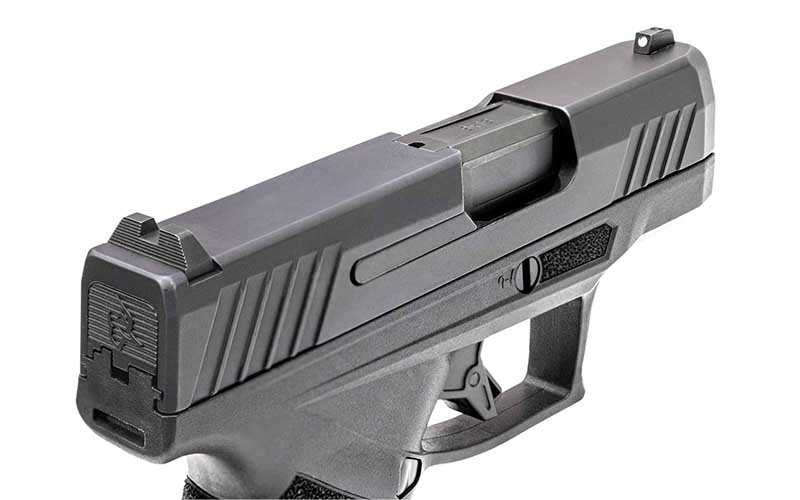
High-void serrations are on the front and rear of the slide, and the muzzle end is beveled on the sides to ease re-holstering. The breech end of the barrel seen in the ejection port has a witness hole in the top that acts as a loaded chamber indicator. Standard slide finish is a black gas nitride treatment for durability, and the stainless steel barrel has a DLC (Diamond-Like Carbon) coating. Two new slide finish options are Tungsten and Troy/Coyote Cerakote, which add a little extra to the price. Control surfaces are Teflon coated; the slide stop is polymer over-molded. Internal metal parts are nickel plated, so everything works smoothly and resistant to corrosion.
The black polymer frame, undergirded by a stainless steel framework, encompasses the grip, which has rough, stippled panels that adorn the sides, front and backstraps. They provide a firm gripping surface to allow maximum control during rapid-fire shooting. They also help if you don’t have an ideal grasp on the pistol during a fast draw, plus they can also prevent the pistol being snatched from your hand in a gun grab. There’s also a stippled area just above the trigger on both sides of the frame that’s an indexing point for your trigger finger to rest.
The front of the trigger guard is squared for those who like to hook their support-hand index finger around it. On the sides, near the butt, where the grip frame and magazine meet, is a scalloped area that’ll help if the magazine must be ripped from the magwell during a malfunction clearance. The magazine release is recessed and reversible for southpaws.
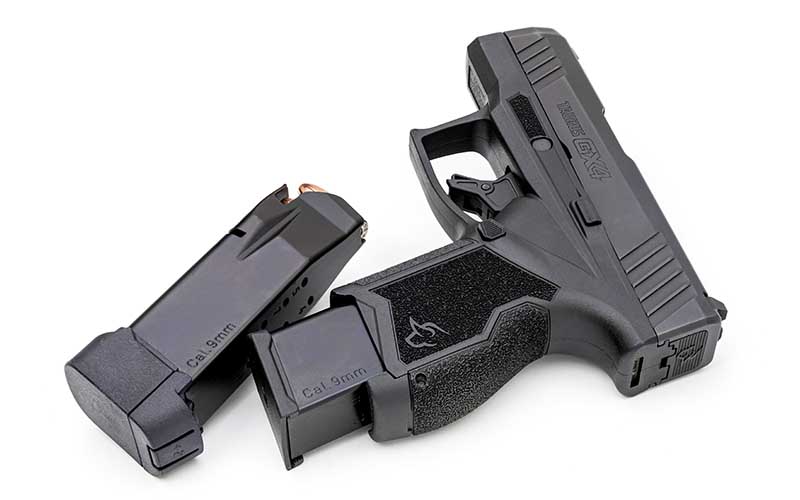
Speaking of magazines, the GX4 comes standard with two, 11-round, flush-base magazines. There’s also a 10-round mag for those who live in restricted areas. Further, you can get an 11-round magazine with a finger rest, plus there are magazines with a two-round extension that give you 13 rounds and someplace to put your pinkie. These are quality Italian-made Mec-Gar magazines, blue steel, with yellow plastic followers.
Unlike the Taurus G2 and G3 that preceded it, the GX4 has a striker-fired, single-action trigger. What you don’t get is second-strike capability; what you do get is a consistent pull with a precise sear break, plus a short and tactile reset. This makes for a trigger that ensures optimal control and is ideal for quick follow-up shots. My Lyman trigger pull gauge gave the average pull weight as 7.3 pounds. Not too light and not too heavy. Take-up was minimal; the same with over-travel. It has a serrated safety blade in the center of the flat-faced target-style trigger shoe that aids in controllability.
The GX4 comes in a black plastic carrying case with a safety padlock and owner’s manual. Also tucked inside is a replacement backstrap with a more pronounced palm swell that affords a higher wrist position, which provides a more natural point of aim for some shooters. Disassembly for cleaning takes a novel approach and uses a take-down pin that’s turned with a flathead screwdriver.
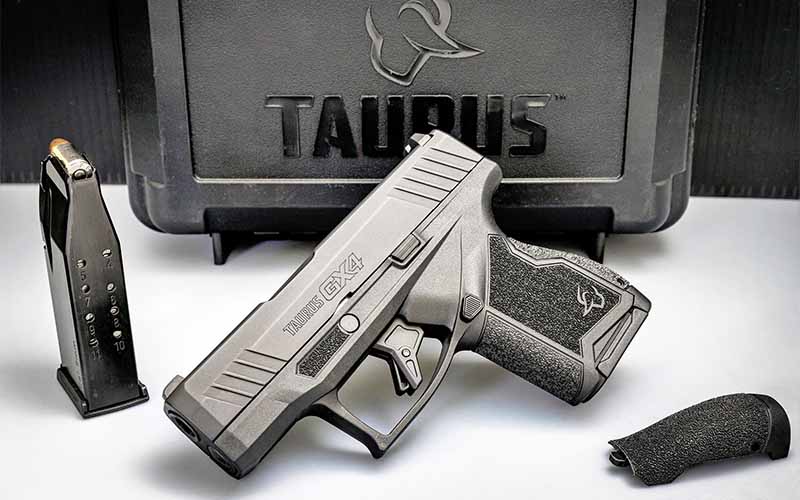
Getting Ready To Rock ’n’ Roll
From the Barnaul Cartridge Plant in Russia comes a load that features a 151-grain FMJ bullet, contained in a zinc-coated steel case. It’s something like a .38 Special, standard-pressure service load coming out of a diminutive 9mm pistol. Hornady provided their Custom load that comes with a 147-grain XTP jacketed hollow-point (JHP) bullet. Another interesting box of ammo came from National Police Ammunition; their offering was a 115-grain HELO Defense round. The bullet is a monolithic copper HP, and it has a black-colored coating.
A well-known load is the Speer Gold Dot; this is the Carry Gun version with a Gen 2, 135-grain GDHP that has the hollow nose plugged with a synthetic material that helps it to pass the FBI protocol testing. Steinel Ammunition supplied their Subcompact Carry load that has a 124-grain solid-copper HP that’s striated almost from the bullet base to tip. Factory specs say 950 fps out of a 3-inch barrel; it did a little better in the GX4. Lastly, I had some of the new Super Vel fodder. The yellow box says it’s rated +P, and they’re not kidding: It carries a 115-grain JHP bullet that has a truncated cone shape and really zips.
There’s always a pause period between the introduction of a new handgun and the availability of a holster to pack it in. In this case, Crossbreed came to the rescue with their SnapSlide OWB belt holster and single magazine pouch. It has 1.75-inch belt slots and can be had with options such as a sweat shield or leather and Kydex color variations. The single magazine pouch is the same construction and worn on the support-side hip. I found that it takes a few days of wear to get the holster “formed” to your belt and hip contour.
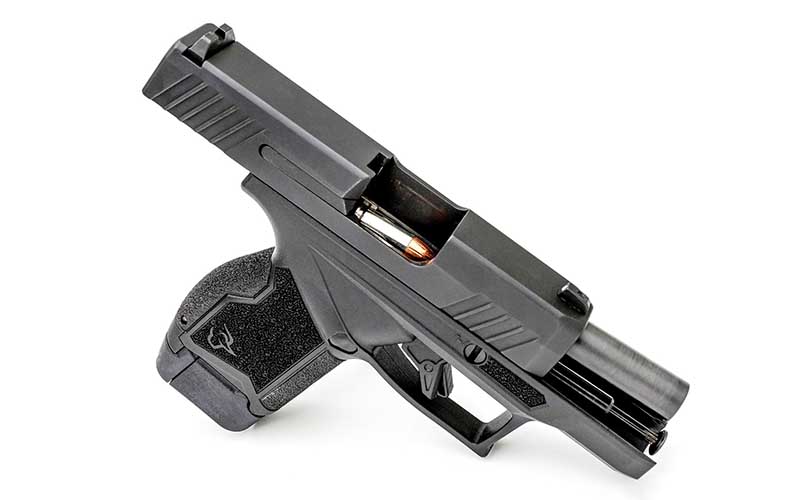
Ready On The Right?
My first task was to set up my Oehler Model 35P chronograph to get some velocity measurements from the 3.06-inch barrel of the GX4. That information is included in the ammunition performance table. I did note one “hiccup” with the Barnaul ammunition, but that was the only time, and during the rest of the session it ran fine. I also had a situation with the Super Vel cartridges. It seems there may have been a problem with the bullet shape and overall length of the cartridge. The sharp-edged jacket at the hollow nose cavity was really digging into the feed ramp. I was having to “bump” the slide into battery after each shot. Hoping this would clear up with more rounds fired, I kept using it through the accuracy potential portion of my test.
Given the barrel length of the GX4, its fixed sights and short sighting radius, I decided that 30 feet would be sufficient for my accuracy analysis protocol. I shot four five-shot groups with each of the test cartridges and went in alphabetical order by the manufacturer’s name. My tightest five-shot group was made using the Speer Gold Dot Carry Gun loads. I had a very well-centered group that measured 1.14 inches. The three other groups gave it an average of 2.09 inches. Second place went to the Hornady Custom XTP with a 1.29-inch five-shot cluster and an average of 1.79 inches. The remainder of the data is in the performance table. The trouble with the Super Vel ammo persisted, so I withdrew it from the test.
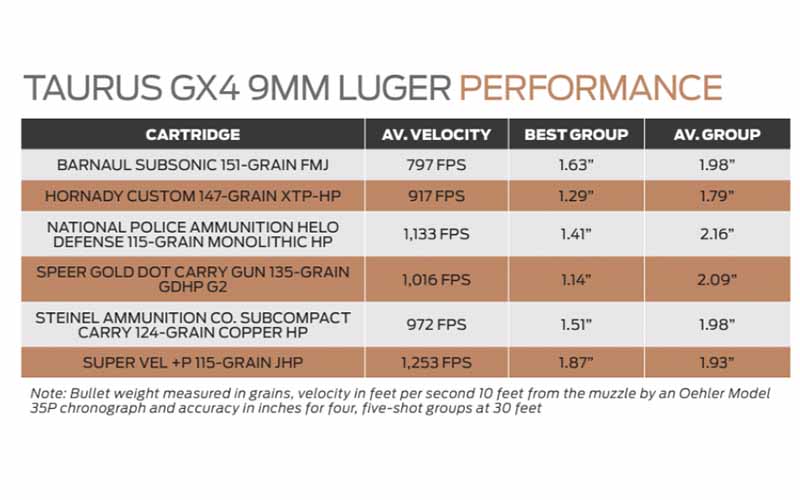
For a practical evaluation, I wanted to see how gun and gear would work during a combat qualification course. This is a short, but realistic course that requires 30 rounds. I had the two 11-round magazines that came with the GX4, and then Taurus sent me two of the 13-round extended magazines. I loaded one of the extended mags with 12 rounds; the other three magazines received six rounds each.
A full-color bad guy target was affixed to my target stand. Made by Guns & Rosa’s Targets LLC, it has B27-type scoring rings, and the bad guy is holding a Glock pistol in his right hand—muzzle toward me! The first stage in my course starts at 3 yards from the target. On signal, after taking an angular step back, I draw from the holster and, using my strong-hand only, fire six shots from a point-shoulder position. The pistol is immediately transitioned to the support hand only, and six more rounds are fired. A reload is performed, and then a 360-degree threat assessment is made before the pistol is slowly worked back in to the holster.
Moving back to 7 yards, with six rounds loaded in the pistol and six in the spare magazine, the target is again engaged. This time using both hands in an isosceles-style stance. Two shots are fired center-mass, and then the pistol is placed in the low-ready position. On signal, the gun is raised for two more shots, and then this is repeated. The magazine is changed and, after the proper process, the gun is re-holstered.
Next, continuing at 7 yards, is the failure, or body-armor, drill. Here, the pistol is drawn from the holster and two rounds fired center-mass and then one to the head. This is repeated again, and then the reload and re-holstering procedure.
The last stage is from the 15-yard barricade. In my case, the barricade was a small tree trunk at the edge of the stream bed. On signal, the gun is presented on the support-side of the barricade, standing and two rounds fired. The shooter then moves to the strong-side barricade and fires two more shots. After that, a strong-side kneeling position is assumed behind cover and the last two rounds fired.
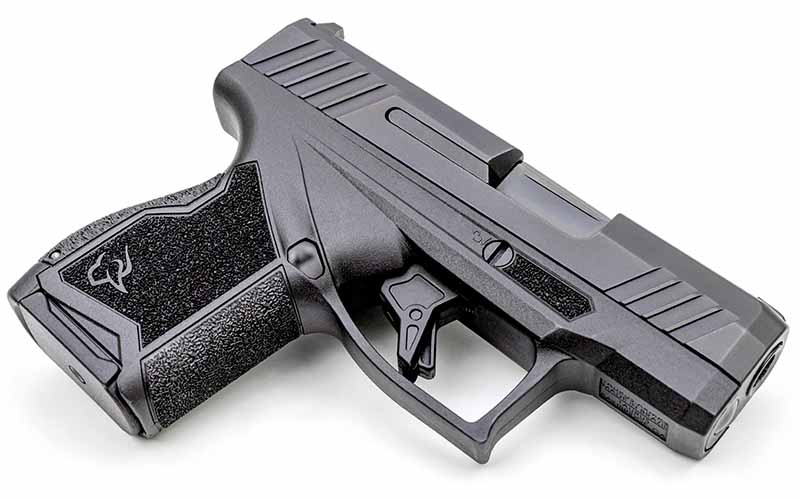
And The Winner Is?
Using the scoring rings and counting 10 points for a head shot in the “fatal triangle,” I dropped 24 points for a 276/300–2X’s. Except for two shots, the bad guy was perforated in the “boiler room.” There were a couple of occasions where that recessed magazine catch was difficult to manipulate, and I ripped out the magazines. If it gets a good solid press, it works just fine. I had no malfunctions during the combat course, and the sights were fairly easy to pick up quickly. I do think I’d opt for aftermarket night sights in a more eye-catching arrangement.
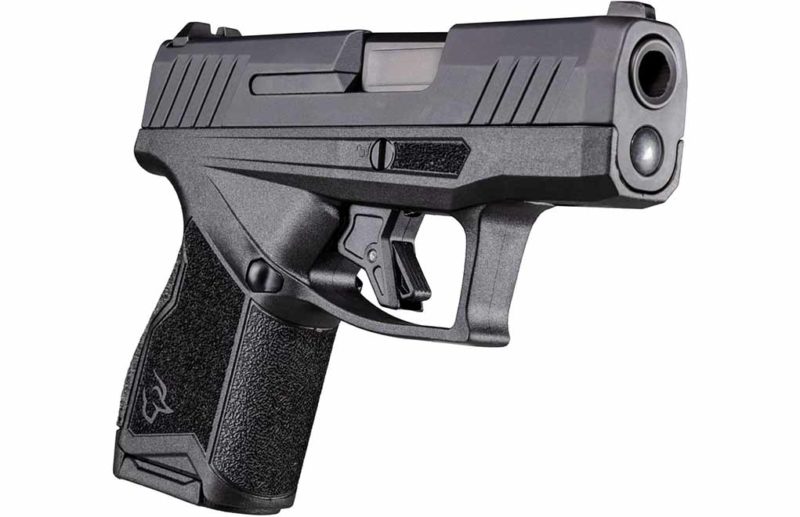
I’ll conclude by saying that I was very favorably impressed with the Taurus GX4. With good ammunition, it ran without a “bobble.” And even though it’s small and light, I had no trouble controlling it in rapid fire due to the ergonomics of the grip frame and the stippled “patches” that grab the hand. Yes, I’d carry this pistol to protect myself and others.
It is not the Taurus of old, but an almost new brand of handguns—like a Phoenix rising up out of the ashes. Another aspect of Taurus is you won’t get the features from any other handgun maker for the price point that comes with most of their products.
Editor's Note: This article originally appeared in the October 2021 issue of Gun Digest the Magazine.
More Taurus Handguns:
- Taurus G3 9mm Pistol
- The G3c : Carry-Ready 9mm From Taurus
- The Taurus 1911 Commander in 9mm
- The .460 S&W Taurus Raging Hunter

Next Step: Get your FREE Printable Target Pack
Enhance your shooting precision with our 62 MOA Targets, perfect for rifles and handguns. Crafted in collaboration with Storm Tactical for accuracy and versatility.
Subscribe to the Gun Digest email newsletter and get your downloadable target pack sent straight to your inbox. Stay updated with the latest firearms info in the industry.

![Best Concealed Carry Guns In 2025 [Field Tested] Wilson Combat EDC X9S 1](https://gundigest.com/wp-content/uploads/Wilson-Combat-EDC-X9S-1-324x160.jpg)


![Best 9mm Carbine: Affordable PCCs [Tested] Ruger Carbine Shooting](https://gundigest.com/wp-content/uploads/Ruger-Carbine-Shooting-100x70.jpg)
![Best AR-15: Top Options Available Today [Field Tested] Harrington and Richardson PSA XM177E2 feature](https://gundigest.com/wp-content/uploads/Harrington-and-Richardson-PSA-XM177E2-feature-100x70.jpg)

I have owned Taurus Semi auto pistols for years and have never had to use their lifetime warranty service. Their PT 92 is an outstanding replica of the Beretta 92 and for the money I would take the Taurus hands down. For 2 years I carried the Taurus G2 and it never failed to go bang at the range. Better yet I only paid 199.00 for it. Now don’t get me wrong I do own some high end guns like a HK USP 45 and a HK USP 9 compact which is my EDC but they are not cheap! The most accurate gun I own in 9mm is a SAR K12 Sport X, it takes CZ75 magazines and is modeled off the CZ 75 which I consider one of the best pistols in the world. Again the SAR K12 handles like a CZ Shadow at half the price. For the street price of the GX4 I will be picking one up in the near future.